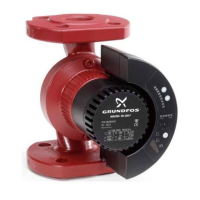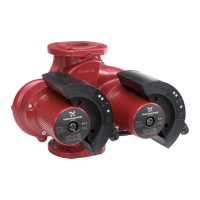12
7.4 Constant-curve duty
To be set with the R100, see section 8. Setting the
pump.
The pump can be set to operate according to a
constant curve, like an uncontrolled pump, see fig. 6.
When the pump has been set to constant-curve
mode with the R100, the setting can be changed on
the control panel or with the R100.
MAGNA 25-100, 32-100, 40-100(D), 50-100
Select one of 9 curves (81 curves with the R100)
between the max. and min. curves, see fig. 5.
MAGNA 25-60, 32-60
Select one of 5 curves (41 curves with the R100)
between the max. and min. curves, see fig. 5.
MAGNA 25-40, 32-40
Select one of 3 curves (21 curves with the R100)
between the max. and min. curves, see fig. 5.
Fig. 5 Operating curves
7.5 Max. or min. curve duty
To be set on the control panel, with the R100 or via
GENI module, see section 8. Setting the pump.
The pump can be set to operate according to the
max. or min. curve, like an uncontrolled pump, see
fig. 6.
This operating mode is available, irrespective of the
control mode.
Fig. 6 Max. and min. curves
The max. curve mode can be selected if an
uncontrolled pump is required.
The min. curve mode can be used in periods in
which a minimum flow is required. This operating
mode is for instance suitable for manual night-time
duty if automatic night-time duty is not desired.
7.6 Temperature influence
To be set with the R100, see section 8. Setting the
pump.
When this function is activated in proportional- or
constant-pressure control mode, the setpoint for
head will be reduced according to the liquid
temperature.
It is possible to set temperature influence to function
at liquid temperatures below 80 °C or below 50 °C.
These temperature limits are called T
max.
. The
setpoint is reduced in relation to the head set
(= 100 %) according to the characteristics below.
Fig. 7 Temperature influence
In the above example, T
max.
= 80 °C has been
selected. The actual liquid temperature T
actual
causes the setpoint for head to be reduced from
100 % to H
actual
.
The temperature influence function requires:
• Proportional- or constant-pressure control mode.
• The pump must be installed in the flow pipe.
• System with flow-pipe temperature control.
Temperature influence is suitable in:
• systems with variable flows (e.g. two-pipe heating
systems), in which the activation of the
temperature influence function will ensure a
further reduction of the pump performance in
periods with small heating demands and
consequently a reduced flow-pipe temperature.
• systems with almost constant flows (e.g. one-pipe
heating systems and underfloor heating systems),
in which variable heating demands cannot be
registered as changes in the head as is the case
with two-pipe heating systems. In such systems,
the pump performance can only be adjusted by
activating the temperature influence function.
Selection of T
max.
In systems with a dimensioned flow-pipe
temperature of:
• up to and including 55 °C, select T
max.
= 50 °C,
• above 55 °C, select T
max.
= 80 °C.
TM03 0551 0205TM00 5547 4596
H
Q
Max.
Min.
Q
H
Max.
Min.
TM01 0626 1797
Note
The temperature influence function
cannot be used in air-conditioning
systems.
30%
100%
80
50
20
H
H
Q
t [°C]
H
actual
T
actual

